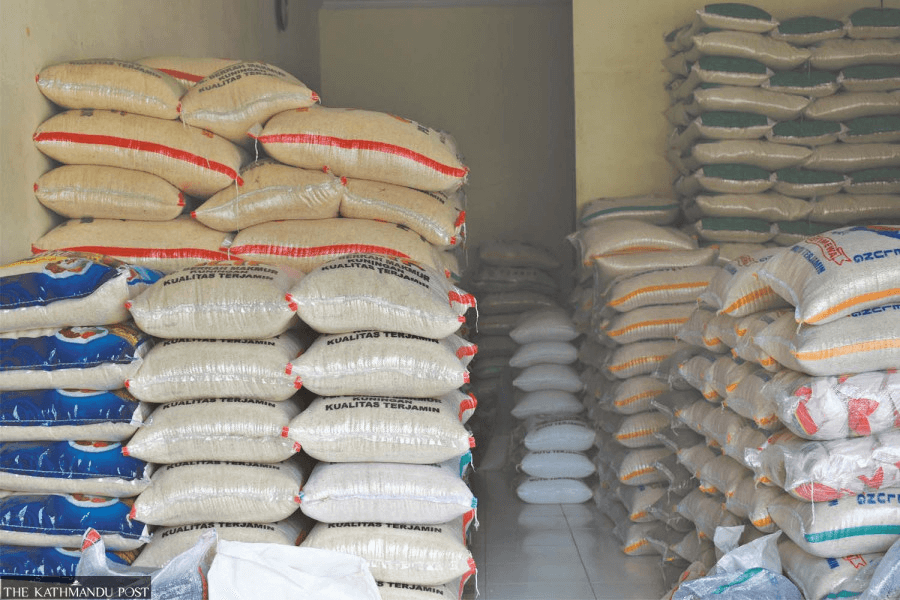Tags
Rice prices on boil despite India removing export taxes
The jeera masino rice, which cost Rs1,600 per 25 kg, jumped to Rs2,500 after India’s export ban in July last year.

Despite India lifting the rice export ban and removing the export duty more than a month ago, prices in the domestic market have refused to come down.
Most of Nepal’s city residents eat fine and long-grain rice imported from India and packaged in Nepal, as the country produces little of these expensive varieties.
Nepali traders, however, say prices may cool down within a few weeks as paddy harvest has begun. Nepal imported rice and paddy worth Rs22 billion in the last fiscal year that ended mid-July, even though India imposed a ban on non-basmati rice exports in July 2023 to ensure the domestic supply and keep prices under control.
In 2021-22, rice and paddy imports from India were worth Rs47.35 billion. Before that, in 2020-21, imports billed Rs50.48 billion.
Immediately after India imposed the ban, the price of rice rose in Nepal by Rs200 to Rs250 per 25 kg bag.
After projecting a bumper harvest, the ban was lifted on September 27, but the minimum export price was imposed. New Delhi set the minimum export price for non-basmati white rice export at $490 per tonne.
The Indian government, however, slashed the duty on parboiled rice export from 20 percent to 10 percent.
India scrapped the minimum export price and duty, removing all forms of taxes, according to a notification issued by the Directorate General of Foreign Trade on October 23.
“As India has projected a bumper rice yield, it has lifted rice export restrictions and all taxes,” said Vibhor Agrawal, executive director of Radha Krishna Rice Mill, producer of Krishnabhog rice.
“The price of rice will cool down once the new harvest reaches market,” he said. Paddy is planted in June-July and harvested in October-November.
India is yet to fix the new rate for paddy. “The new rate will decide the price in Nepal,” said Agrawal.
However, traders say that the price of jeera masino rice, Rs2,500 per 25 kg bag, has decreased to Rs2,400, a drop of a meagre Rs100.
Before the ban, jeera masino rice cost Rs1,600 per 25 kg.
Domestic rice traders said they have started importing rice after the ban has been lifted.
Agrawal said domestic traders have started selling a 25 kg bag of normal rice in Kathmandu for Rs2,100 to Rs2,150.
Except for sona mansuli, domestic producers’ price of katrani rice under premium jeera masino has not been fixed yet. “So jeera masino rice is being sold at the existing rate,” said Agrawal.
“As we have old stock remaining, which we imported by paying 20 percent export duty to India and 7 percent duty to Nepali customs, we are selling at the existing rate,” said Agrawal.
As India has removed 20 percent of the export duty, the price will come down by Rs300 per bag, said Agrawal. A 20 percent export duty costs Rs500 to Rs600 per bag.
In Nepal, rice smuggling from India to Nepal has surged to alarming levels since the southern neighbour banned exports of the staple grain.
The research, ‘Dynamics of informal cross-border trade in agricultural products between Nepal and India,’ prepared by the South Asia Watch on Trade, Economics and Environment (SAWTEE) in partnership with the International Food Policy Research Institute, showed that only 40 percent of rice is imported to Nepal from India through a formal channel.
Domestic rice producers said it is estimated that around 8,000 bags of rice (25-30 kg size) are being smuggled into Nepal daily from various Nepal-India border points.
According to reports, smugglers supply rice on bicycles, and a single smuggler does it up to 10 times a day. The smuggled rice is cheaper compared to rice imported by paying taxes.
Smuggling has affected the government taxes and rice mills’ incomes in Nepal.
“We have not imported a new paddy stock due to the festival. The new stock will arrive without duty and tax,” said Agrawal.
India is the world’s largest rice exporter, accounting for more than 40 percent.
Despite the El Niño phenomenon, Nepali farmers harvested 5.72 million tonnes of paddy last fiscal year.
According to officials at the agriculture ministry, paddy production may be slightly affected this year due to the heavy rainfall in late September that triggered floods and landslides in most parts of Nepal.
According to the preliminary loss and damage assessment report released by the National Disaster Risk Reduction and Management Authority under the home ministry on Thursday, the floods and landslides from September 26 to 28 affected 65,380 hectares of agricultural land and 26,698 livestock, resulting in an estimated economic loss of Rs5.88 billion.
The report said that the significant impact on agriculture threatens food security and farmers’ livelihoods, who rely heavily on their land and livestock for income.
https://kathmandupost.com/money/2024/11/11/rice-prices-on-boil-despite-india-removing-export-taxesPublished Date: November 11, 2024






